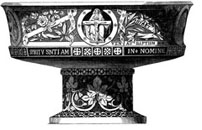
‘Anglican Use’ Catholic Parishes
A PLACE HAS BEEN PREPARED
This year on the Feast of St. Joseph, my wife, Therese, and I attended a solemn Evensong service held at our parish church in San Antonio. The congregation was composed for the most part of the children of the parish school, whose pure voices were especially enchanting as they sang the responses — including the following — in the graceful, venerable English of the Book of Common Prayer:
Verse: O Lord, show thy mercy upon us.
Response: And grant us thy salvation.
V: O Lord, save the State.
R: And mercifully hear us when we call upon thee.
V: Endue thy Ministers with righteousness.
R: And make thy chosen people joyful.
V: O Lord, save thy people.
R: And bless thine inheritance.
V: Give us peace in our time, O Lord.
R: For it is thou, Lord, only, that makest us dwell in safety.
V: O God, make clean our hearts within us.
R: And take not thy Holy Spirit from us.
This same style of language, so much a part of the culture of the English-speaking world, can also be heard in Masses celebrated in the parish church, which was designed and built in 1987 to resemble a 15th-century English country church. The interior, with its stained glass windows, rich medieval colors, rood screen, communion rail, high altar, wineglass pulpit, and Lady Chapel, coupled with the exquisite liturgy, produced an overall effect that could easily move one to tears.
You May Also Enjoy
This year commemorates the bicentennial of the birth of St. Vincent Pallotti, under whose patronage…
Arthur Schlesinger said the most "tenacious tradition of paranoic agitation in American history has been anti-Catholicism." This book is a product of it.
Although I am a Baptist, I occasionally visit a certain high-church Episcopal (Anglo-Catholic, really) church…

